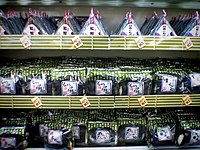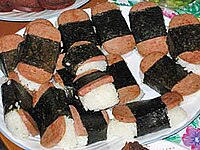This is an old revision of this page, as edited by Thatdog (talk | contribs) at 02:16, 31 December 2009 (→External links: wikibooks cookbook page was deleted some time ago). The present address (URL) is a permanent link to this revision, which may differ significantly from the current revision.
Revision as of 02:16, 31 December 2009 by Thatdog (talk | contribs) (→External links: wikibooks cookbook page was deleted some time ago)(diff) ← Previous revision | Latest revision (diff) | Newer revision → (diff)
Onigiri (御握り; おにぎり), also known as omusubi (御結び; おむすび) or rice ball, is a Japanese food made from white rice formed into triangular or oval shape and often wrapped in nori (seaweed). Traditionally, an onigiri is filled with pickled ume (umeboshi), salted salmon, katsuobushi, kombu, tarako, or any other salty or sour ingredient as a preservative. Because of the popularity of onigiri in Japan, most convenience stores there stock onigiri with various fillings and flavors. There are even specialized shops whose only products are onigiri for take out.
Overview


Onigiri is not a form of sushi, despite a common misconception. While onigiri is made with plain rice (perhaps lightly salted), sushi is rice with sugar and vinegar added. Onigiri makes rice portable and easy to eat as well as preserving it, while sushi originated as a way of preserving fish.
Onigiri are also found in many convenience stores in Taiwan and South Korea. In the latter, it is called samgak gimbap because of its triangular shape.
Fillings
The typical fillings in Japan are as follows;
- Fish
- Salted salmon
- Katsuobushi (dried skipjack tuna)
- Canned tuna
- Seafood
- Pickles
- Seasoning
A variety of other ingredients such as chicken and beef are used in Hawaiian cuisine. The favorite such variation there uses Spam and is known as Spam musubi.
History

In Lady Murasaki's eleventh-century diary Murasaki Shikibu Nikki, she writes of people eating rice balls. At that time, onigiri were called tonjiki and often consumed at outdoor picnic lunches. Other writings dating back as far as the seventeenth century state that many samurai stored rice balls wrapped in bamboo leaves as a quick lunchtime meal during war, but the origins of onigiri are much earlier even than Lady Murasaki. Before the use of chopsticks became widespread in the Nara period, rice was often rolled into a small ball so that it could be easily picked up. In the Heian period, rice was also made into small rectangular shapes known as tonjiki so that they could be piled onto a plate and easily eaten.
From the Kamakura period to the early Edo period, onigiri was used as a quick meal. This made sense as cooks simply had to think about making enough onigiri and did not have to concern themselves with serving. These onigiri were simply balls of rice flavored with salt. Nori did not become widely available until the Genroku era in the mid-Edo period, when the farming of nori and fashioning it into sheets became widespread.
It was believed that onigiri could not be mass produced as the hand-rolling technique was considered too difficult for a machine to replicate. In the 1980s, however, a machine that made triangular onigiri was devised. This was initially met with skepticism because, rather than having the filling traditionally rolled inside, the flavoring was simply put into a hole in the onigiri, and the hole was hidden by nori. Since the onigiri made by this machine came with nori already applied to the rice ball, over time the nori became unpleasantly moist and sticky, clinging to the rice. A packaging improvement allowed the nori to be stored separately from the rice. Before eating, the diner could open the packet of nori and wrap the onigiri. The limitation of the machines that required using a hole for filling the onigiri instead of rolling the filling with the rice actually made new flavors of onigiri easier to produce as this cooking process did not require changes from ingredient to ingredient.
Culture
| This section needs expansion. You can help by adding to it. (November 2009) |
As a popular staple of the Japanese diet for centuries, onigiri have often been referred to in a variety of media, from woodblock prints to books to film. In the popular, long-running “Zatoichi” Japanese movies and television shows set in Japan’s Edo period, almost every episode has the protagonist "Ichi" eating onigiri, which he either eats at inns and restaurants or carries with him on his travels.
In Harvest Moon for the Super Nintendo, the main character Jack often eats onigiri while working.
See also
References
- "Japanese food" (in Korean). Dusan Encyclopedia. Retrieved 21 February 2008.
오니기리(お握り)는 우리나라의 주먹밥과 매우 비슷하다. 밥에 소금으로 간을 하고, 그것에 다양한 재료를 섞어 넣고 삼각형으로 뭉친 것이다. 그것을 김으로 둘러서 먹는데, 한국에는 삼각김밥이라는 이름으로 들어와 있다.
- A Taste of Japan, Donald Richie, Kodansha, 2001, ISBN 4770017073